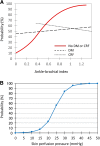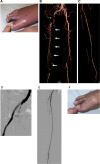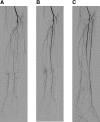Contemporary critical limb ischemia: Asian multidisciplinary consensus statement on the collaboration between endovascular therapy and wound care
- PMID: 29654408
- PMCID: PMC6153892
- DOI: 10.1007/s12928-018-0523-z
Contemporary critical limb ischemia: Asian multidisciplinary consensus statement on the collaboration between endovascular therapy and wound care
Abstract
The burden of peripheral artery disease (PAD) and diabetes in Asia is projected to increase. Asia also has the highest incidence and prevalence of end-stage renal disease (ESRD) in the world. Therefore, most Asian patients with PAD might have diabetic PAD or ESRD-related PAD. Given these pandemic conditions, critical limb ischemia (CLI) with diabetes or ESRD, the most advanced and challenging subset of PAD, is an emerging public health issue in Asian countries. Given that diabetic and ESRD-related CLI have complex pathophysiology that involve arterial insufficiency, bacterial infection, neuropathy, and foot deformity, a coordinated approach that involves endovascular therapy and wound care is vital. Recently, there is increasing interaction among cardiologists, vascular surgeons, radiologists, orthopedic surgeons, and plastic surgeons beyond specialty and country boundaries in Asia. This article is intended to share practical Asian multidisciplinary consensus statement on the collaboration between endovascular therapy and wound care for CLI.
Keywords: Bacterial infection; Collaboration; Foot deformity; Interdisciplinary; Ischemia; Peripheral artery disease.
Conflict of interest statement
Osami Kawarada reports honorarium for lectures and advisory board fees from Boston Scientific Corporation, honorarium for lectures and research grants from Terumo, and a consultancy fee from Medtronic. Hsuan-Li Huang reports honorarium for lectures from Boston Scientific and Medtronic. Testuya Nakama reports honorarium for lectures from Abbott Vascular, Boston Scientific, and Medtronic and consulting fee from Boston Scientific and Century Medical Inc. Naoki Fujimura reports consulting fee from W.L. Gore and Associates. Bryan Ping-Yen Yan reports honorarium for lectures from Boston Scientific Corporation, Cook Medical, and Medtronic, research grants from Medtronic and Boston Scientific Corporation, and consultancy fee from Medtronic and Cook Medical. Robbie K George reports honorariums for/consultancy agreements with Medtronic Corporation, Bard Corporation, Cook Medical, and Abbot Vascular. Kan Zen, Shinobu Aayabe, Donghoon Choi, Su Hong Kim, Jiyoun Kim, Taku Kato, Yoshinori Tsubakimoto, Shigeo Ichihashi, Akihiro Higashimori, Masahiko Fujihara, Tomoyasu Sato, Skyi Yin-Chun Pang, Chumpol Wongwanit, Yew Pung Leong, Benjamin Chua, Yoshiaki Yokoi, Hisashi Motomura, and Hideaki Obara report no conflict of interest.
Figures















Similar articles
-
Lower Extremity Revascularization in End-Stage Renal Disease.Vasc Endovascular Surg. 2016 Nov;50(8):582-585. doi: 10.1177/1538574416674843. Epub 2016 Oct 23. Vasc Endovascular Surg. 2016. PMID: 27770080
-
Cost-effectiveness of revascularization for limb preservation in patients with end-stage renal disease.J Vasc Surg. 2014 Aug;60(2):369-374.e1. doi: 10.1016/j.jvs.2014.02.003. Epub 2014 Mar 20. J Vasc Surg. 2014. PMID: 24657067 Free PMC article.
-
Ischemic Charcot foot: different disease with different treatment?J Cardiovasc Surg (Torino). 2013 Oct;54(5):561-6. J Cardiovasc Surg (Torino). 2013. PMID: 24002384
-
Systematic review and meta-analysis of outcomes of lower extremity peripheral arterial interventions in patients with and without chronic kidney disease or end-stage renal disease.J Vasc Surg. 2021 Jan;73(1):331-340.e4. doi: 10.1016/j.jvs.2020.08.032. Epub 2020 Sep 1. J Vasc Surg. 2021. PMID: 32889074
-
Critical limb ischemia and its treatments: a review.J Cardiovasc Surg (Torino). 2015 Oct;56(5):775-85. Epub 2015 Apr 14. J Cardiovasc Surg (Torino). 2015. PMID: 25868972 Review.
Cited by
-
Successful limb salvage by endovascular treatment for critical limb ischemia subsequent to acute limb ischemia.Oxf Med Case Reports. 2019 Oct 31;2019(10):omz103. doi: 10.1093/omcr/omz103. eCollection 2019 Oct. Oxf Med Case Reports. 2019. PMID: 31772742 Free PMC article.
-
Referral, Diagnosis, and Pharmacological Management of Peripheral Artery Disease: Perspectives from Taiwan.Acta Cardiol Sin. 2023 Jan;39(1):97-108. doi: 10.6515/ACS.202301_39(1).20220815A. Acta Cardiol Sin. 2023. PMID: 36685160 Free PMC article. Review.
-
2024 TSOC/TSPS Joint Consensus: Strategies for Advanced Vascular Wound Management in Arterial and Venous Diseases.Acta Cardiol Sin. 2024 Jan;40(1):1-44. doi: 10.6515/ACS.202401_40(1).20231220A. Acta Cardiol Sin. 2024. PMID: 38264067 Free PMC article.
-
Two effective cases of additional pedal artery angioplasty for severe lower limb ischemia following acute thrombotic artery occlusion with hypercoagulable state diseases.CVIR Endovasc. 2020 Sep 28;3(1):71. doi: 10.1186/s42155-020-00166-7. CVIR Endovasc. 2020. PMID: 32986148 Free PMC article.
-
Presentation Pattern of Lower Extremity Endovascular Intervention versus Percutaneous Coronary Intervention.J Atheroscler Thromb. 2020 Aug 1;27(8):761-768. doi: 10.5551/jat.53330. Epub 2019 Nov 21. J Atheroscler Thromb. 2020. PMID: 31748468 Free PMC article.
References
Publication types
MeSH terms
LinkOut - more resources
Full Text Sources
Other Literature Sources
Medical
Research Materials
Miscellaneous

